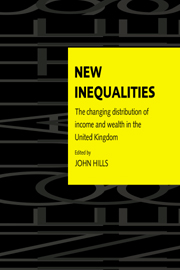Book contents
- Frontmatter
- Contents
- List of figures
- List of tables
- List of contributors
- Acknowledgements
- 1 Introduction: after the turning point
- Part I Income distribution
- Part II Components of income
- Part III Spatial aspects
- 11 Aspects of the changing geography of poverty and wealth
- 12 Two nations? Changing patterns of income and wealth in two contrasting areas
- Part IV Income and wealth
- Bibliography
- Index
12 - Two nations? Changing patterns of income and wealth in two contrasting areas
from Part III - Spatial aspects
Published online by Cambridge University Press: 22 September 2009
- Frontmatter
- Contents
- List of figures
- List of tables
- List of contributors
- Acknowledgements
- 1 Introduction: after the turning point
- Part I Income distribution
- Part II Components of income
- Part III Spatial aspects
- 11 Aspects of the changing geography of poverty and wealth
- 12 Two nations? Changing patterns of income and wealth in two contrasting areas
- Part IV Income and wealth
- Bibliography
- Index
Summary
Background: the national pattern
Spatial
The 1980s and early 1990s have been marked by some of the sharpest changes in recent years in the relative position of different areas and regions within Britain in social and economic terms. Rapidly rising unemployment in the early 1980s most seriously affected regions linked to traditional manufacturing industries – the North West, the North East and the Midlands – that had also declined during the 1970s. Within such regions heavily industrialised urban areas typically declined more rapidly. However there were other parts of the country that remained relatively buoyant. The ESRC urban studies of the mid-1980s (Hausner, 1986, 1987) recorded that the fastest growing areas were in the urban south-east, particularly the London periphery, in towns such as Milton Keynes, Basingstoke, and Basildon. Though such areas were not immune from the recession of the early 1980s, unemployment fell sharply in the latter part of the decade to reach very low levels. Recovery was far less rapid and delayed in the more traditional industrial urban areas. Typically the pattern of the 1980s was reasonably described in terms of a ‘growing divide’ essentially between north and south (actually between south-east with the east against the rest of the country).
However, during the early 1990s the position altered dramatically. Rising unemployment and economic decline has been most rapid in those very regions that experienced the most rapid growth in the late 1980s.
- Type
- Chapter
- Information
- New InequalitiesThe Changing Distribution of Income and Wealth in the United Kingdom, pp. 292 - 318Publisher: Cambridge University PressPrint publication year: 1996
- 12
- Cited by



